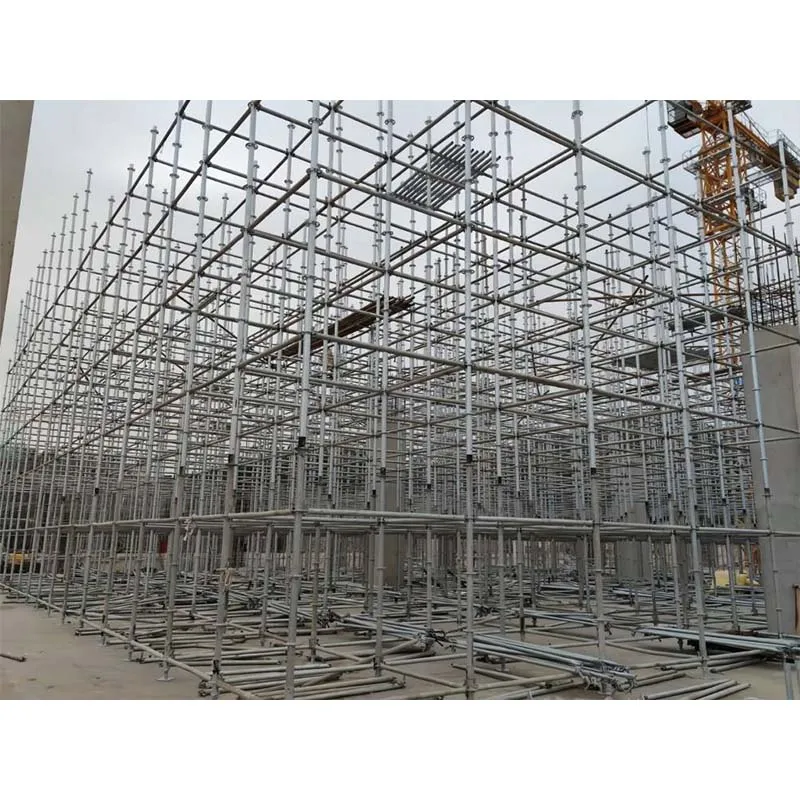ພ.ພ. . 08, 2025 13:54 Back to list
Ringlock Scaffolding: The Industry Standard for Safe and Efficient Access
In today’s fast-paced construction, infrastructure, and industrial maintenance sectors, safety and efficiency are non-negotiable. That’s why ringlock scaffolding has become one of the most trusted access systems worldwide. Made from high-strength steel or aluminum, this modular metal scaffolding system offers unmatched stability, speed of assembly, and adaptability — especially in complex or high-rise jobs.

Whether you're planning a large-scale build or an industrial maintenance project, understanding how industrial scaffolding works — and why ringlock is leading the way — can help you make smarter purchasing and project decisions.
What Is Ringlock Scaffolding?
Ringlock scaffolding is a modular, rosette-based scaffolding system used for temporary work platforms and structural support in construction and heavy industry. Unlike traditional tube-and-coupler systems, ringlock uses a unique rosette node design — a circular disc welded to the vertical standard that allows multiple connections at various angles using wedge-locks.
Key components include:
Standards (verticals) with fixed rosettes every 0.5m or 1m
Ledgers (horizontals) with forged wedge heads
Diagonal braces for lateral stability
Base jacks, steel planks, staircases, and guardrails
This system locks securely without the need for bolts or tools, allowing for rapid assembly and precise alignment in virtually any application.
Why Choose Metal Scaffolding?
Metal scaffolding, especially made from galvanized steel or high-strength aluminum, has become the global standard for commercial and industrial access systems. Compared to timber or bamboo, metal scaffolding offers:
✅ Greater load-bearing capacity
✅ Higher durability and weather resistance
✅ Fire and corrosion resistance
✅ Consistent quality and safety performance
✅ Reusability, reducing long-term costs
In particular, ringlock metal scaffolding combines the durability of steel with the speed and modular flexibility needed for modern job sites.
Advantages of Ringlock Scaffolding in Industrial Use
Industrial scaffolding involves working in challenging environments — like oil refineries, power plants, shipyards, and manufacturing plants — where access, safety, and uptime are critical.
Ringlock is especially suited for these environments due to:
|
Feature |
Benefit |
|
Modular Design |
Easily adapts to complex geometries or confined spaces |
|
Quick Assembly |
Reduces labor costs and downtime |
|
All-Angle Connections |
Ideal for non-linear or rounded structures (e.g., tanks, turbines) |
|
Load-Bearing Strength |
Supports heavy-duty tools, crews, and materials |
|
Fewer Components |
Simplifies logistics and reduces inventory clutter |
|
Durable Galvanized Finish |
Corrosion-resistant and ideal for long-term industrial exposure |
Whether for a shutdown, routine maintenance, or heavy structural work, ringlock scaffolding is the go-to system for industrial access and support.
Applications of Ringlock and Metal Scaffolding
Construction
High-rise building access
Facade work and rebar installation
Interior finishing and ceiling installation
Infrastructure
Bridge and tunnel work
Dam maintenance
Road signage and support structures
Industrial Scaffolding
Refineries and power plants
Chemical plants and tank farms
Manufacturing facilities and process plants
Shipbuilding and offshore platforms
The modularity of ringlock makes it perfect for environments where access needs to be both flexible and safe.
Comparing Ringlock to Other Scaffolding Types
|
System |
Pros |
Cons |
|
Ringlock |
Fast assembly, flexible design, fewer components |
Higher upfront cost |
|
Cuplock |
Good for vertical loads, fewer ledgers than ringlock |
Less flexible at complex angles |
|
Tube & Coupler |
Fully customizable with individual pipes |
Labor-intensive and slower to assemble |
|
Frame Scaffold |
Quick setup for low-rise, interior jobs |
Not suitable for complex or heavy-duty industrial projects |
Ringlock is considered the most advanced scaffolding system for multi-level, multi-angle, and high-load projects — making it a top choice for professional contractors and industrial engineers.
Buying or Renting Ringlock Scaffolding
What to look for in a supplier:
Galvanized or hot-dip finish
Precision welds and load certifications
Modular compatibility (interchangeable with major brands)
Inventory support for large projects
Safety certifications (EN 12810, ANSI, OSHA, etc.)
Ringlock Scaffolding Price Guide
Prices vary by material, size, and quantity. Here’s a general estimate (USD):
|
Component |
Unit Price Range |
|
Standard (vertical) |
$10 – $25 per piece |
|
Ledger (horizontal) |
$7 – $15 per piece |
|
Diagonal Brace |
$8 – $18 per piece |
|
Steel Plank |
$12 – $30 per piece |
|
Jack Base |
$5 – $12 per piece |
|
Full Set (per m²) |
$35 – $65 per m² (new) |
Bulk pricing and project packages can lower per-unit costs significantly. For budget-conscious buyers, refurbished or secondhand metal scaffolding is also widely available.
Ringlock Scaffolding FAQs
Q1: How fast can ringlock scaffolding be assembled?
A: With trained workers, 2–3 times faster than tube-and-coupler systems. Most setups can be done without special tools.
Q2: Is ringlock safe for heavy loads?
A: Yes. Properly installed, it can handle high loads — suitable for masonry, structural work, or mechanical support.
Q3: Can it be used indoors?
A: Absolutely. Lighter aluminum ringlock options are ideal for indoor maintenance and renovation jobs.
Q4: What’s the difference between ringlock and cuplock scaffolding?
A: Ringlock offers more angular flexibility, fewer components, and faster assembly — making it more versatile overall.
Q5: Is ringlock scaffolding reusable?
A: Yes. With proper care, galvanized ringlock components can be reused for 10+ years or over 100 construction cycles.
If you’re serious about speed, safety, and structural integrity on-site, ringlock scaffolding is a smart investment. Whether you’re sourcing for construction, maintenance, or industrial shutdowns, this modern metal scaffolding system offers unmatched versatility and long-term value.
From city skyscrapers to offshore rigs, ringlock is the backbone of modern industrial scaffolding systems — built to perform, built to last.
-
Timber Beam H20 Formwork Delivers Unmatched Versatility Reliability
ຂ່າວAug.08,2025
-
Precision Circular Column Formwork For Perfect Concrete Results
ຂ່າວAug.08,2025
-
High-Quality Adjustable Steel Prop for Slab Formwork Solutions
ຂ່າວAug.08,2025
-
High Strength Tie Rod Concrete Formwork for Commercial Buildings
ຂ່າວAug.08,2025
-
Heavy-Duty Steel Scaffolding Ladder for Construction Projects
ຂ່າວAug.08,2025
-
Advanced Formwork Solutions for Modern Construction
ຂ່າວAug.08,2025